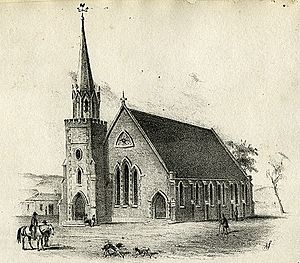Scots Church, Adelaide facts for kids
Quick facts for kids Scots Church |
|
|---|---|

Scots Church
|
|
| 34°55′18″S 138°36′19″E / 34.92162°S 138.6052°E | |
| Country | Australia |
| Denomination | Uniting (since 1977) |
| Previous denomination |
|
| History | |
| Former name(s) | Chalmers Church |
| Status | Church |
| Founded | 3 September 1850 |
| Founder(s) | Reverend John Gardner |
| Dedication | Rev. Thomas Chalmers |
| Dedicated | 6 July 1851 |
| Architecture | |
| Functional status | Active |
| Architect(s) | English & Brown |
| Architectural type | Church |
| Style | Gothic Revival |
| Completed | 1858 (spire) |
| Construction cost | A£2,572 |
| Specifications | |
| Spire height | 37 metres (120 ft) |
| Materials | Stone; shingles |
| Administration | |
| Synod | South Australia |
Scots Church is a special building in Adelaide, South Australia. It's a Uniting Church located at the corner of North Terrace and Pulteney Street. This stone church was one of the first churches built in Adelaide. It was started in 1850 by a group called the Free Church of Scotland and was first known as Chalmers Church.
Contents
History of Scots Church
Building the First Church
Many people who moved to South Australia from Europe after 1836 supported the Free Church of Scotland. They invited Reverend John Gardner from Scotland to lead them. He arrived in March 1850.
Reverend Gardner helped create Chalmers Free Church. It was named after Reverend Thomas Chalmers, who was an important leader of the Free Church of Scotland.
Gardner quickly bought land for the church from John Morphett. He hired English & Brown, a company owned by Thomas English and Henry Brown, to design and build the church. The first stone was laid on 3 September 1850. The very first church service in the new building happened on 6 July 1851.
Church Costs and Features
The land and building cost £2,572. This was more than the original plan of £1,800. They even tried to save money by using a shingle roof instead of more expensive slate tiles.
In 1858, a tall spire was added to the church. It was about 37 meters (120 feet) high and cost an extra £200. A large bell was also brought from England and given to the church by Thomas Elder.
Changes Over Time
In 1865, several Presbyterian churches in South Australia joined together. This included the Free Presbyterian Church, the United Presbyterian Church, and the Church of Scotland. They formed one big group called the Presbyterian Church of South Australia.
Later, in 1901, when the Australian states joined together to form a country, the main Presbyterian churches in each state also joined. Chalmers Church then became part of the Presbyterian Church of Australia.
In 1929, Chalmers Church joined with another church called Flinders Street Presbyterian Church. They decided to call their new combined church "Scots Church." The old Flinders Street property was sold in 1956. The money from the sale helped build new parts on the western side of Scots Church. Some parts of the Flinders Street church, like its organ and stained glass windows, were moved to Scots Church.
In 1977, most of the Presbyterian Church of Australia joined with the Methodist and Congregational churches. They created a new church group called the Uniting Church in Australia (UCA). Scots Church is part of the Uniting Church today. Reverend Ian B. Tanner, who was the minister at Scots Church, became the first leader of the Uniting Church in South Australia.
Scots Church is a very old and important building. It was added to the South Australian Heritage Register on 11 September 1986. It is the second-oldest church building in the city of Adelaide.
People of Scots Church
Ministers
- John Gardner
- John Davidson (1870–1877)
- David Paton (1877–1906)
- Arthur John Wade (1907-1913)
- Thomas Tait (1914–1915)
- James Arthur Seymour (1916–1928)
- Norman L. D. Webster (1929–1939)
- Ian B. Tanner (1963–1980)
Organists
- Roy Mellish (1910–1919)
Other Notable People
- Harriet Miller Davidson

